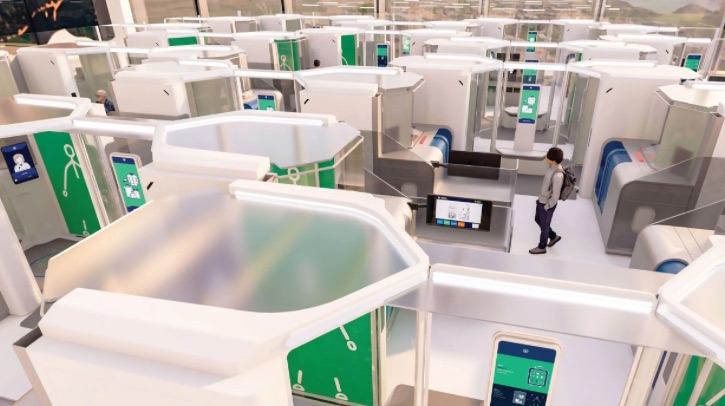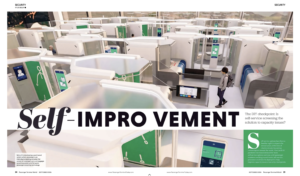Self-service options have been a familiar sight in airports for several years, with rows of check-in kiosks becoming commonplace around the world. The Covid-19 pandemic increased demand for more self-service options and now, with passenger numbers reaching record levels, self-service processes could also be deployed to help improve capacity issues at security checkpoints.
The United States Transportation Security Administration (TSA) certainly sees the potential. With the agency now screening as many as three million passengers in a single day, it is continuing to innovate to keep up with passenger demand without compromising on security. Its Innovation Checkpoint at Harry Reid International Airport (LAS) in Las Vegas is a much-publicized self-service screening prototype unveiled in March, in cooperation with the Department of Homeland Security’s Science and Technology Directorate (DHS S&T).
Announcing the initiative in March, TSA said the aim is “to provide a near self-sufficient passenger screening process while enabling passengers to directly receive on-person alarm information and allow for the passenger self-resolution of those alarms to reduce instances where a pat-down or secondary screening procedure would be necessary.”
“Data collection… will continue to inform future design requirements and system development.”
Michele Tomerlin, TSA
The concept has been discussed at TSA for several years. “When I looked at the concept in 2018, I thought, ‘It’s very interesting, but this will never happen in my lifetime here at TSA,’ recalls Tomerlin. “Yet here we are in 2024 and it’s already in an airport.”
First prototype in action

In late 2021, DHS S&T awarded contracts to three companies – Micro-X, Vanderlande and Voxel Radar – to develop self-screening concepts, prototypes and hardware. The self-service screening initiative is part of DHS S&T’s Screening at Speed Program, which is designed to increase aviation security effectiveness from curb to gate while dramatically reducing wait times and improving the passenger experience.
“Meanwhile, Dormakaba provides the access control system as a passenger navigates through each stage of the security checkpoint,” continues Karoly. “By putting the four capabilities together, you end up with a fully automated self-service screening process.”
“We are keeping an open mind about what the future of self-service screening might look like.”
Michele Tomerlin, TSA
Each station includes a video monitor with multistep instructions and a help button that connects to the live TSA TSO. If a passenger doesn’t pass initial screening due to an item left in their pocket, for example, the entry door reopens so they can remove the item before being rescreened in the passenger portal. The Dormakaba access control system prevents the passenger from moving forward to the next stage until they have properly divested. Once passengers have completed the required screening process and are cleared for travel, automated exit doors open so they can gather their belongings and head to their flights. TSA PreCheck passengers are the first to have the option to use the new system.
In this case, TSA may be hoping that what happens in Vegas does not stay in Vegas, and could potentially roll out the self-service screening system at other airports. Passenger feedback and data on the system’s performance, design, cybersecurity, human factors and other variables will inform future design requirements and system development and help TSA fine-tune the solution.
“This self-service prototype allows our trusted travelers to complete the screening process at their own pace,” says TSA administrator David Pekoske. “Testing at the Innovation Checkpoint in Las Vegas gives us an opportunity to collect valuable user data and insights, and explore opportunities to apply parts of the prototype to other airport security checkpoints.”

Tomerlin is watching the prototype closely as early results will influence the program’s next steps. “TSA is still very much in the live test phase with self-service screening, and we are keeping an open mind about what the future of self-service screening might look like at other airports.” TSA’s three-pronged mission is to improve checkpoint efficiency, enhance the passenger experience and increase security, with security being the main priority, of course. As Tomerlin says, “New technologies really need to significantly improve security foremost and move the needle on the other two priorities.”
Karoly says K2 is ready to assist TSA should the self-service screening initiative expand. “If and when this technology gets added to TSA’s Acceptable Capability List (ACL), it is envisioned that we will assist the airlines, airport authorities and general contractors in deploying this equipment and working through TSA’s capability acceptance process.”
An eye on the future
At the end of 2023, Micro-X began a multimonth demonstration and data collection of one of the two systems it is developing for the TSA and DHS S&T self-screening initiative. For this, the company’s small computed tomography (CT) x-ray system is being tested at DHS’s Transportation Security Laboratory (TSL) in Atlantic City, New Jersey. Test engineers are collecting screening images to validate the system’s performance and assist with future algorithm development.
The company is also developing a pod-based system where passengers use individual screening consoles comprising a compact carry-on baggage screening system and flat-panel passenger screening technology. The system provides feedback to the passenger if additional screening is needed. TSA is keen to introduce the concept of self-screening to passengers in advance, so that interest will be piqued and some level of understanding and acceptance reached before the technology is in full use.
For example, in January, TSA used the Consumer Electronics Show as a platform to introduce the Micro-X prototype via virtual reality headsets at its booth at the show. Visitors could virtually pass through security, scanning their bags and themselves, to get an idea of how the future airport checkpoint might look. The event was useful for TSA too, as it received feedback from the public that could shape future developments of the self-screening concept and systems.

Micro-X expects the first self-screening pod to be ready to test some time in 2025 and ultimately intends to integrate multiple pods into one full screening lane to simultaneously accommodate multiple travelers.
Monash University’s Design Health Collab team in Australia assisted Micro-X with the design direction of the pods, with a focus on enhancing security measures and improving the passenger experience while restoring human dignity during the airport experience. The work was conducted in collaboration with other research labs in Monash’s Art, Design and Architecture faculty, including XYX Lab around gender-sensitive design and the Mobility Design Lab, which provided expertise in passenger flow and transportation. Micro-X is also working with Elenium Automation, which has equipped several airport terminals with a high degree of automation and passenger verification technology.
“Passenger volumes are increasing, so the checkpoint of the future will be different.”
Keith Jeffries, K2 Security Screening Group
Last year, Voxel Radar sent its in-motion advanced imaging technology passenger panel sensors to TSL, where DHS S&T staff collected mock passenger scans to understand the system’s full capabilities. The Voxel Radar proposal aims to develop a prototype for next-generation millimeter-wave panel sensors to enable a passenger self-screening solution. The company’s prototype sensor is designed to line walls or curved surfaces to collect data in real time with an open architecture that enables rapid system integration and algorithm upgrades. The system will work with the natural motion of passengers removing their belongings to achieve thorough inspection for prohibited and/or concealed items. It will also provide near-real-time feedback to the passenger if additional screening or divestiture is necessary. Voxel Radar’s sensors could be integrated into the Micro-X prototype or developed as independent screening technology.

Changes overcome challenges
Karoly’s colleague at K2 Security Screening Group, VP Keith Jeffries, was a former federal security director at Los Angeles International Airport. He believes self-screening has a lot of potential but also presents challenges that will need to be considered before full implementation.
“The goal is to increase security effectiveness and efficiency so that passengers can get through the security checkpoint faster and with minimal use of TSA manpower,” he says. “There is minimal engagement with TSA personnel, and it gives the traveler a near touchless environment. However, it is currently unclear what the throughput advantage is for a self-service screening lane compared with a traditional TSA PreCheck or regular TSA checkpoint lane. The prototype in use at Harry Reid enables TSA PreCheck passengers to use the selfscreening lane, but some of those passengers have stated that they can get through security faster by using the traditional TSA PreCheck lane. But it’s a new process and will take time for passengers to get accustomed to the new self-screening lane.”
Jeffries says if self-service screening is approved by TSA, the decision to have a self-screening lane should be considered during a new terminal design phase. “The self-screening lane has a very large footprint. If the concept is approved by TSA, airports that are interested in deploying this capability will need to have square footage at the security checkpoint to accommodate this self-screening system.”
He believes we’ll see changes to the systems currently under development with TSA and DHS S&T: “It is unlikely we will see this specific version of the self-screening lane as the norm in the near future. However, TSA and DHS S&T are doing the correct thing, prototyping and assessing with real passengers. There is still so much to learn, more information to gather and improvements to be made.”
Airports and governments around the world will be watching TSA’s progress carefully, especially those that are planning new terminal construction or extensions. “Passenger volumes are increasing, so the checkpoint of the future will be different,” Tomerlin says. “It is difficult to suggest yet what might be the norm, because TSA and its partners in innovation are very much still at work developing, testing and evaluating conceptual designs – to include self-service screening technologies.”
This article originally appeared in the June 2024 issue of Passenger Terminal World. To view the magazine in full, click here.



